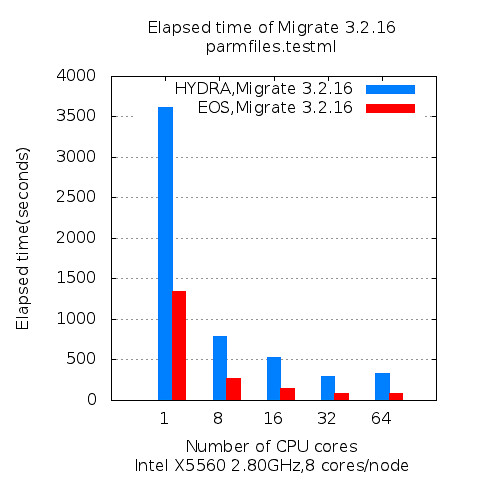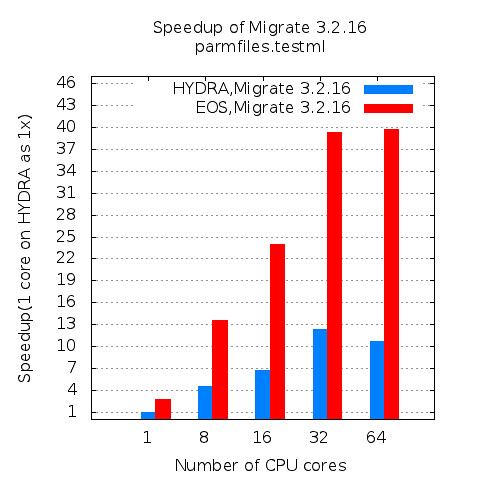Introduction
Migrate estimates effective population sizes and past migration rates between n population assuming a migration matrix model with asymmetric migration rates and different subpopulation sizes[1].
Experimental environment
In this experiment, the performance of serial version, which runs on single core, is measured as a basis of comparison. Then, the number of core is increased to 8, 16, 32, and 64. Each compute node has two quad core 2.8Ghz Intel Xeon X5560 processors based on Nehalem architecture and 24GB DDR3 DRAM with 1333Ghz clock cycle[2].
Since each compute node has 8 cores, 8 compute nodes are required for 64 core job. parmfile.testml is used as an input file for experiment. The only change made to it for this experiment is that value of menu parameter is changed to ‘NO’ to be able to run it in batch mode on EOS and HYDRA[3][4][5].
Results
Migrate keeps improving its performance up to 32 cores on both HYDRA and EOS[Fig.1].
[Figure 1]
However, with 64 cores, performance starts falling on HYDRA[Fig.2] and it does not perform better than 32 cores on EOS[Fig.3].


[Figure 2]
[Figure 3]
On EOS, 8 cores show 5 times faster than 1 core. There is almost no speedup between 32 and 64 cores. On HYDRA, 8 cores bring 4.5 times speedup compared to 1 core. 32 cores show best performance and 64 cores are a little bit slower than 32 cores.
[Figure 4]
Migrate runs more than twice faster on EOS than on HYDRA in general. With 8 cores EOS is about 3 times faster than HYDRA[Fig.4].
References
1.http://popgen.sc.fsu.edu/Migrate/Info.html
2.http://sc.tamu.edu/systems/eos/hardware.php
3.http://sc.tamu.edu/help/eos/batch/
4.http://sc.tamu.edu/help/hydra/batch.php
5.http://sc.tamu.edu/systems/hydra/hardware.php
References
1.http://popgen.sc.fsu.edu/Migrate/Info.html
2.http://sc.tamu.edu/systems/eos/hardware.php
3.http://sc.tamu.edu/help/eos/batch/
4.http://sc.tamu.edu/help/hydra/batch.php
5.http://sc.tamu.edu/systems/hydra/hardware.php



No comments:
Post a Comment